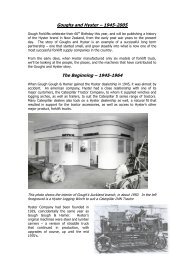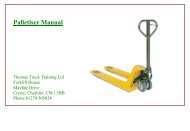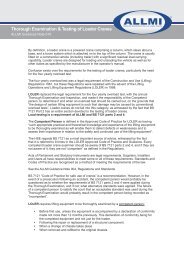all defects reported to the supervisor - Thomas Truck Training
all defects reported to the supervisor - Thomas Truck Training
all defects reported to the supervisor - Thomas Truck Training
Create successful ePaper yourself
Turn your PDF publications into a flip-book with our unique Google optimized e-Paper software.
<strong>Thomas</strong> <strong>Truck</strong> <strong>Training</strong> 16 Sackville Street Thraps<strong>to</strong>n 01832 731261 EXTRACT OF MANUAL www.3ttt.info<br />
1. Base and slewing system<br />
2. Body<br />
3. Boom System<br />
4. Hydraulic Cylinders<br />
5. Control valve assembly<br />
6. Stabiliser Legs<br />
7. Oil Tank<br />
8. Manufacturer’s Plate<br />
ALL DEFECTS REPORTED TO THE SUPERVISOR<br />
Page 1 of 1 TTT Services©2002
<strong>Thomas</strong> <strong>Truck</strong> <strong>Training</strong> 16 Sackville Street Thraps<strong>to</strong>n 01832 731261 EXTRACT OF MANUAL www.3ttt.info<br />
Typical control leaver layout<br />
As a hook<br />
The Function of <strong>the</strong> Control Leavers<br />
The crane is operated by means of leavers on <strong>the</strong><br />
control valve. If <strong>the</strong> crane is used on hook duties<br />
<strong>the</strong> leaver sequence as above will be operative<br />
• A) Slew ( RED )<br />
• B) Inner boom<br />
• C) Outer boom<br />
• D) Extensions<br />
• E) Support legs<br />
• F) Support legs<br />
Page 2 of 2 TTT Services©2002<br />
With a <strong>to</strong>ol<br />
When <strong>the</strong> loader is equipped for <strong>to</strong>ol<br />
operation <strong>the</strong> outrigger legs are controlled<br />
with <strong>the</strong> help of a double-function control<br />
valve connected in series, using leavers<br />
G & H<br />
• A) Slew ( RED )<br />
• B) Inner boom<br />
• C) Outer boom<br />
• D) Extensions<br />
• E) Attachments<br />
• F) Attachments<br />
• G) Support legs<br />
• H) Support legs
<strong>Thomas</strong> <strong>Truck</strong> <strong>Training</strong> 16 Sackville Street Thraps<strong>to</strong>n 01832 731261 EXTRACT OF MANUAL www.3ttt.info<br />
Daily Inspection (pre-operational checks)<br />
It is <strong>the</strong> responsibility of <strong>the</strong> driver <strong>to</strong> ensure that <strong>the</strong> machine<br />
is safe and in good working order. It should be examined<br />
when <strong>the</strong> driver carries out <strong>the</strong> daily inspection of <strong>the</strong> lorry at<br />
<strong>the</strong> start of <strong>the</strong> day or shift or at any time that <strong>the</strong> driver is<br />
required <strong>to</strong> use a machine that has not been inspected that day<br />
All faults found during this inspection should be recorded on a<br />
daily inspection record and <strong>reported</strong> <strong>to</strong> <strong>the</strong> <strong>supervisor</strong>. Under<br />
no circumstances should <strong>the</strong> machine be used if found <strong>to</strong> be<br />
unsafe.<br />
Should any faults develop whilst in operation <strong>the</strong> driver<br />
should telephone <strong>the</strong> depot and report <strong>the</strong> fault <strong>to</strong> <strong>the</strong><br />
<strong>supervisor</strong> or appropriate person. Do not be tempted <strong>to</strong> use<br />
it until <strong>the</strong> fault is rectified satisfac<strong>to</strong>rily<br />
Checks should be made of <strong>all</strong> auxiliary equipment<br />
including slings, lifting tackle and attachments.<br />
ADDITIONAL TO THE LORRY CHECKS…………<br />
Security Of Loader Stabiliser legs and feet<br />
Slings and Lifting Tackle Stabiliser Extensions<br />
Security of locking pins Power take off<br />
Lifting Hook Hydraulic Oil<br />
Hydraulic Booms Hydraulic Components for leaks<br />
Slewing Devices Hydraulic Controls<br />
Extension arms Pressure relief valves<br />
Auxiliary Devices General condition of machine<br />
DO NOT USE AN UNSAFE MACHINE<br />
DO NOT ATTEMPT TO REPAIR UNLESS QUALIFIED TO DO SO<br />
RECORD AND REPORT ALL FAULTS<br />
Page 3 of 3 TTT Services©2002
<strong>Thomas</strong> <strong>Truck</strong> <strong>Training</strong> 16 Sackville Street Thraps<strong>to</strong>n 01832 731261 EXTRACT OF MANUAL www.3ttt.info<br />
orry Loading Procedures<br />
Page 4 of 4 TTT Services©2002<br />
Lifting Tackle: Check List
<strong>Thomas</strong> <strong>Truck</strong> <strong>Training</strong> 16 Sackville Street Thraps<strong>to</strong>n 01832 731261 EXTRACT OF MANUAL www.3ttt.info<br />
Lifting Tackle Check list<br />
1. Only slings and lifting tackle that has been<br />
thoroughly examined and supplied by <strong>the</strong><br />
Company should be used.<br />
2. Slings and lifting tackle should be visu<strong>all</strong>y<br />
inspected on each occasion before use.<br />
3. Any sling showing signs of fraying or<br />
thinning should be destroyed and<br />
replacements obtained from your<br />
<strong>supervisor</strong>.<br />
4. Any item of lifting tackle that shows signs<br />
of damage or wear should not be used and<br />
must be <strong>reported</strong> <strong>to</strong> your <strong>supervisor</strong>.<br />
5. Slings and lifting tackle should be clearly<br />
marked with <strong>the</strong> safe working load.<br />
6. Ropes should never be used for <strong>the</strong> lifting<br />
loads.<br />
7. Chains, slings and hooks should not be<br />
dragged along <strong>the</strong> ground.<br />
INSPECT YOUR LIFTINGTACKLE<br />
DAILY. IF IT<br />
IS DAMAGED, REPLACE IT.<br />
Page 5 of 5 TTT Services©2002
<strong>Thomas</strong> <strong>Truck</strong> <strong>Training</strong> 16 Sackville Street Thraps<strong>to</strong>n 01832 731261 EXTRACT OF MANUAL www.3ttt.info<br />
Slings: Lifting Equipment<br />
Most slings are coloured (see below) <strong>the</strong> colour determines <strong>the</strong> slings lifting capacity. It must also<br />
be noted that <strong>the</strong> type of lifting mode being used (Vertical, Choker, etc) decreases <strong>the</strong> slings lifting<br />
capacity and this must be taken in <strong>to</strong> account at <strong>all</strong> times.......<br />
Typical colour code chart. Always check for every sling.<br />
Capacity<br />
Colour<br />
1 Tunline Mauve 1000 800 2000 1800 1400 1000<br />
2 Tunlines Green 2000 1600 4000 3600 2800 2000<br />
3 Tunlines Yellow 3000 2400 6000 5400 4200 3000<br />
4 Tunlines Orange 4000 3200 8000 7200 5600 4000<br />
5 Tunlines Red 5000 4000 10000 9000 7000 5000<br />
6 Tunlines Brown 6000 4800 12000 10800 8400 6000<br />
8 Tunlines Blue 8000 6400 16000 14400 11200 8000<br />
SWL 10’000kg White 10000 8000 20000 18000 14000 10000<br />
SWL 10’000kg White 12000 9600 24000 21600 16800 12000<br />
SWL 10’000kg White 15000 12000 30000 27000 21000 15000<br />
SWL 10’000kg White 20000 16000 40000 36000 28000 20000<br />
Page 6 of 6 TTT Services©2002
<strong>Thomas</strong> <strong>Truck</strong> <strong>Training</strong> 16 Sackville Street Thraps<strong>to</strong>n 01832 731261 EXTRACT OF MANUAL www.3ttt.info<br />
Capacity tables: lifting<br />
MAXIMUM UTILISATION OF THE LOADER CAPACITY<br />
For safe handling of loads which need <strong>the</strong> full capacity of <strong>the</strong><br />
crane you should operate according <strong>to</strong> <strong>the</strong> following<br />
recommendations:-<br />
Range A Use mainly <strong>the</strong> inner and extension boom,<br />
operate with <strong>the</strong> boom system as straight as<br />
possible with <strong>the</strong> minimum reach on <strong>the</strong><br />
extension boom.<br />
Range B Use mainly <strong>the</strong> outer and extension boom,<br />
ideal position of <strong>the</strong> inner boom about 10<br />
over ground plane<br />
AS THE LIFTING RADIUS INCREASES – THE MAXIMUM<br />
SAFE WORKING LOAD MUST BE REDUCED.<br />
The curves on <strong>the</strong> load diagram indicate <strong>the</strong><br />
maximum lifting capacity of your crane at a certain<br />
outreach or height.<br />
Before handling a certain load it is important <strong>to</strong> check<br />
on <strong>the</strong> diagram in which range your crane is capable<br />
of handling this load. During operation do not<br />
increase <strong>the</strong> outreach beyond this range.<br />
If <strong>the</strong> load capacity at a certain outreach has been<br />
mistaken/exceeded resulting in boom drop, you should<br />
quickly shorten <strong>the</strong> outreach <strong>to</strong> get <strong>the</strong> load within<br />
correct range.<br />
Page 7 of 7 TTT Services©2002
<strong>Thomas</strong> <strong>Truck</strong> <strong>Training</strong> 16 Sackville Street Thraps<strong>to</strong>n 01832 731261 EXTRACT OF MANUAL<br />
www.3ttt.info<br />
On Site: Loading/Unloading<br />
When you first arrive on site, particular attention should be given <strong>to</strong> <strong>the</strong> ground that <strong>the</strong> vehicle will be standing<br />
on, and potential hazards <strong>to</strong> yourself and <strong>the</strong> vehicle in <strong>the</strong> surrounding area.<br />
When <strong>the</strong> crane is in use under normal working conditions, <strong>the</strong> load imposed on <strong>the</strong> tyres and outriggers in<br />
enormous. You should make sure <strong>the</strong> ground <strong>the</strong> vehicle will be on is firm and will take <strong>the</strong> weight of <strong>the</strong> vehicle<br />
and <strong>the</strong> outriggers.<br />
You should take particular care that <strong>the</strong> tyres and outriggers will not be on or near cellars, ground cavities, weak<br />
decking or near <strong>the</strong> edge of excavations.<br />
If required, you will need <strong>to</strong> pack <strong>the</strong> area under <strong>the</strong> outriggers <strong>to</strong> spread <strong>the</strong> weight of <strong>the</strong> vehicle. In certain<br />
conditions, special reinforcement will be required. If in doubt, competent advice should be sought.<br />
Consideration should also be given <strong>to</strong> potential hazards like overhead power cables, areas where <strong>the</strong> public have<br />
access, and underground services such as gas mains and electricity cables.<br />
Page 8 of 8 TTT Services©2002
<strong>Thomas</strong> <strong>Truck</strong> <strong>Training</strong> 16 Sackville Street Thraps<strong>to</strong>n 01832 731261 EXTRACT OF MANUAL www.3ttt.info<br />
DANGER: POWER LINES<br />
Cranes coming near <strong>to</strong> or <strong>to</strong>uching overhead power cables can kill <strong>the</strong> driver or people nearby.<br />
Never load or unload near <strong>to</strong> live overhead power cables. A safe general rule is <strong>to</strong> get no closer than <strong>the</strong> maximum extension of<br />
<strong>the</strong> crane plus 6 metres.<br />
Do not drive under overhead power cables with your crane raised or extended.<br />
Should your vehicle come in<strong>to</strong> contact with a live cable <strong>the</strong> following action must be taken.<br />
Page 9 of 9 TTT Services©2002
<strong>Thomas</strong> <strong>Truck</strong> <strong>Training</strong> 16 Sackville Street Thraps<strong>to</strong>n 01832 731261 EXTRACT OF MANUAL www.3ttt.info<br />
EXTRACTS FROM THE 1974 HEALTH AND SAFETY AT WORK ACT<br />
EMPLOYERS DUTY:<br />
Section 2 (1). It sh<strong>all</strong> be <strong>the</strong> duty of every employer <strong>to</strong> ensure, so far<br />
as is reasonably practicable, <strong>the</strong> health, safety and welfare at work<br />
of his employees.<br />
Section 2 (2). Without prejudice <strong>to</strong> <strong>the</strong> generality of an employers<br />
duty under <strong>the</strong> preceding subsection, <strong>the</strong> matters <strong>to</strong> which that duty<br />
extends in particular:-<br />
a) The provision and maintenance of plant and systems of<br />
work that are, so fare as is reasonably practicable, safe<br />
and without risks <strong>to</strong> health.<br />
b) Arrangements for ensuring, so far as is reasonably<br />
practicable, safety and absence of risks <strong>to</strong> health in<br />
connection with <strong>the</strong> use, handling, s<strong>to</strong>rage and transport<br />
of articles and substances.<br />
c) The provision of such information, instruction, training<br />
and supervision, as in necessary <strong>to</strong> ensure, so far as is<br />
reasonably practicable, <strong>the</strong> health and safety at work of<br />
his employees.<br />
MANUFACTURERS DUTY:-<br />
Section 6 (1). It sh<strong>all</strong> be <strong>the</strong> duty of any person who designs,<br />
manufactures, imports or supplies any article for use at work:<br />
a) To ensure, so far as is reasonably practicable, that <strong>the</strong><br />
article is so designed and constructed as <strong>to</strong> be safe and<br />
without risks <strong>to</strong> health when properly used.<br />
Page 10 of 10 TTT Services©2002<br />
EMPLOYEES DUTY:-<br />
Section 7 (a). It sh<strong>all</strong> be <strong>the</strong> duty of every employee while at work:<br />
a) To take reasonable care for <strong>the</strong> health and safety of<br />
himself and o<strong>the</strong>r persons who may be affected by his<br />
acts or omissions.<br />
b) As regards any duty or requirements imposed on his<br />
employer or any o<strong>the</strong>r person by or under any of <strong>the</strong><br />
relevant statu<strong>to</strong>ry provisions, <strong>to</strong> co-operate with him<br />
so far as is necessary <strong>to</strong> enable that duty or<br />
requirement <strong>to</strong> be performed or complied with.<br />
c) Section 8. No person sh<strong>all</strong> intention<strong>all</strong>y or recklessly<br />
interfere with or misuse anything provided in <strong>the</strong><br />
interests of health, safety or welfare in pursuance of<br />
any of <strong>the</strong> relevant statu<strong>to</strong>ry provisions.<br />
ONUS OF PROOF<br />
Section 40. In any proceedings for an offence under any of <strong>the</strong><br />
relevant statu<strong>to</strong>ry provisions consisting of a failure <strong>to</strong> comply<br />
with a duty or requirement <strong>to</strong> be something so far as is<br />
reasonably practicable or <strong>to</strong> use <strong>the</strong> best practicable means <strong>to</strong><br />
do something, it sh<strong>all</strong> be for <strong>the</strong> accused <strong>to</strong> prove, (as <strong>the</strong> case<br />
may be) that it was not practicable <strong>to</strong> do more than was in fact<br />
done <strong>to</strong> satisfy <strong>the</strong> duty or requirement or that <strong>the</strong>re was no<br />
better practicable means than was in fact used <strong>to</strong> satisfy <strong>the</strong><br />
duty or requirement
<strong>Thomas</strong> <strong>Truck</strong> <strong>Training</strong> 16 Sackville Street Thraps<strong>to</strong>n 01832 731261 EXTRACT OF MANUAL www.3ttt.info<br />
Page 11 of 11 TTT Services©2002






